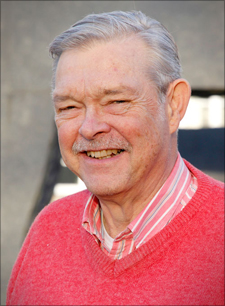Professor Carl Christian Tscherning has died
Professor at the Niels Bohr Institute, Carl Christian Tscherning has died at the age of 72. Carl Christian Tscherning was a professor of geodesy, which is the study of the Earth’s shape and size. Even though he retired at the age of 70, he continued to work as an emeritus and was actively researching and supervising students.

Professor at the Niels Bohr Institute, Carl Christian Tscherning has died at the age of 72. Carl Christian Tscherning was a professor of geodesy, which is the study of the Earth’s shape and size.
Denmark is one of the world’s leading countries when it comes to researching the Earth’s gravitational field. This is due not the least to Professor Carl Christian Tscherning. The effect of gravity across the surface of the earth varies due to variations in the subsurface – the greater the mass, the greater the force of gravity. In order to measure the force of gravity in an area, you combine the location with the strength of the gravitational force and it’s direction (for example, gravitational force on a mountainside does not point straight down but slants inwards towards the mass of the mountain).
Difficult mapping
Carl Christian Tscherning told how in the 60s they were sent away to Greenland for several months each year and travelled with measuring equipment from place to place, making measurements of astronomical positions and measurements of gravity at the location.
“It was very difficult to get around in the mountains and this limited the number of measurements and then there was the problem of the light, as it is light around the clock in the summer and this means that it could be difficult to see the stars you needed for the astronomical calculation of longitude and latitude. It took forever and everyone was looking for a more effective method for measuring gravitational fields,” he explained.
Many thought the solution might lie in measurements from satellites orbiting the Earth. This would mean that they wouldn’t only have scattered point measurements, but a complete mapping of the Earth’s gravitational field. However, the problem was that you had to combine different types of measurements and you had to be able to handle huge amounts of data at the same time.
Breakthrough in the research
There were admittedly theoretical models, but Christian Tscherning made the theoretical method feasible in practice by developing a computer programme GEOCOL for the calculations and he worked to make the programme even better over the next 20 years. The new method was a breakthrough in the exploration of the Earth’s gravitational field.
In the early years, the method was used on satellites already in orbit around the Earth. But they were positioned to high up to be able to measure small variations in the gravitational field. In March 2009, the European Space Agency, ESA, launched a new satellite, GOCE, which would map the gravitational field of the entire Earth. “It is a life’s work that has been completed,” said Carl Christian Tscherning, who was very committed to his work and was very popular among colleagues.
“Carl Christian was a very good colleague and friend – always supportive and helpful and he was also popular with the students. He was active to the end, both in teaching and advising. He was the supervisor for a very large number geodesists and has therefore had a central role in Danish geodesy. He is considered one of the greats,” says Aksel Walløe Hansen, Deputy Head of Institute at the Niels Bohr Institute.
Carl Christian Tscherning died of a sudden illness the night of Friday, 24 October.
